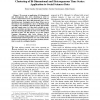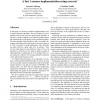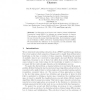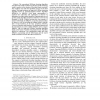WCE
2007
14 years 8 months ago
2007
— The build up of water ice on aircraft flight surfaces poses a significant safety risk. As a result, much effort has gone into studying this problem in order to understand how i...
NIPS
1994
14 years 8 months ago
1994
This paper studies the convergence properties of the well known K-Means clustering algorithm. The K-Means algorithm can be described either as a gradient descent algorithmor by sl...
DMIN
2006
14 years 8 months ago
2006
We present an application of bi-dimensional and heterogeneous time series clustering in order to resolve a Social Sciences issue. The dataset is the result of a survey involving mo...
ATAL
2003
Springer
15 years 7 days ago
2003
Springer
This paper examines a method of clustering within a fully decentralized multi-agent system. Our goal is to group agents with similar objectives or data, as is done in traditional ...
BVAI
2005
Springer
15 years 14 days ago
2005
Springer
We propose an algorithm that groups points similarly to how human observers do. It is simple, totally unsupervised and able to find clusters of complex and not necessarily convex s...
ESORICS
2005
Springer
15 years 16 days ago
2005
Springer
The freedom and transparency of information flow on the Internet has heightened concerns of privacy. Given a set of data items, clustering algorithms group similar items together...
COMPGEOM
2006
ACM
15 years 1 months ago
2006
ACM
In this paper we develop an efficient implementation for a k-means clustering algorithm. The novel feature of our algorithm is that it uses coresets to speed up the algorithm. A ...
MLDM
2007
Springer
15 years 1 months ago
2007
Springer
In this paper we propose a new criterion, based on Minimum Description Length (MDL), to estimate an optimal number of clusters. This criterion, called Kernel MDL (KMDL), is particu...
CEC
2008
IEEE
15 years 1 months ago
2008
IEEE
—The conventional K-Means clustering algorithm must know the number of clusters in advance and the clustering result is sensitive to the selection of the initial cluster centroid...
ICDM
2009
IEEE
15 years 1 months ago
2009
IEEE
This work examines under what conditions compression methodologies can retain the outcome of clustering operations. We focus on the popular k-Means clustering algorithm and we dem...




